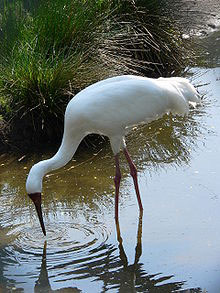The group or population that used to arrive to this part of the globe is extinct

Siberian Cranes would never come to Indiaagain – it is now confirmed. These birds have not been sighted in thispart of the world since 2001 – and now it is totally unlikely that they wouldever come to this part of the globe again, to be specific, the KeoladeoNational Park at Bharatpur in Rajasthan.
It is sad that now there is no scope forthe Siberian Cranes (Grus leucogeranus) to visit India as the group orpopulation that used to arrive here is extinct. Even a few years ago, therewere some hopes, but now that the Central population itself is extinct, thehopes are lost.
It is pertinent to mention here that theKeoladeo National Park (formerly known as Bharatpur Bird Sanctuary) is a WorldHeritage Site, a Ramsar (Convention of Wetlands) site and Important Bird Area(IBA) identified by Cambridge-headquartered Birdlife International.
“It’s a sad story,” says Dr Asad Rahmani, theDirector of Bombay Natural History Society (BNHS), who is one of India'sleading ornithologists.
The Siberian Cranes have stopped visitingus mainly due to the problem on the migratory route. “Perhaps they were shot inAfghanistan where they use to stop at Al-Astabha wetland for few days/weeks,before flying over to Pakistan and reaching India directly. They never stoppedin Pakistan,” Dr Rahmani said.
The Western and Central populations (ofSiberian) are almost extinct. “We used to get birds from Central populationthat used to breed in Ob River delta (vast shallow wetland of thousands of kmsquare). The Eastern population is doing well and more than 3,400 were sighteda year ago in Poyang Lake in China. However, this population is also in dangerdue to various development activities in Poyang Lake. There is a proposal tobuild a dyke on at the entrance of the Yangtse River to Poyang. This couldaffect the water level and could be a real threat to the wintering SiberianCranes,” Dr Rehmani pointed out.
It will be very difficult to revive theCentral population but these days with technology nothing is impossible. “Weneed the will to do. However, we can have semi-captive population of theSiberian Crane in Keoladeo to educate the people the importance of thesebirds,” he added.
Noted environmentalist Bittu Sahgal, the Editor of Sanctuary Asia, said thatthere is little hope of them returning because the flock that used to visitIndia has no members left that remember the route. “Their vanishing was amongthe early warnings of the mismanagement of wetlands in India, but the lessonswere ignored then, as they are being ignored now with our Sarus cranes, thetallest flying birds in the world, in full retreat,” he added.